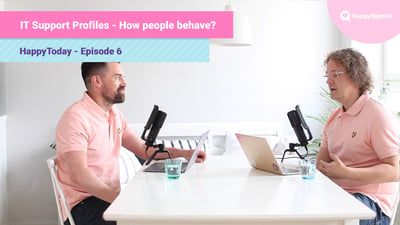IT knows a lot about devices. Every metric, such as uptime, latency, CPU spikes, network speed, etc., is measurable.
But what about how people feel when they use those devices?
Until now, technical and human insights have lived in different worlds, and the full picture has been largely ignored.
With Nexthink and HappySignals, IT leaders finally get the full picture:
- Nexthink shows what’s happening technically
- HappySignals shows how it feels for employees, in real time and at scale.
The result: IT teams can prioritize what really matters, spend smarter, and prove their impact on business productivity.
Use case 1: Deeper understanding of employee experience
Most IT organizations have visibility into devices and apps but not into the people using them.
Nexthink tracks the digital signals: performance, reliability, and network behavior. HappySignals adds the human signals: happiness, perceived lost time, and productivity impact.
Together, they give you a 360° view of experience.
Imagine comparing telemetry with emotion:
- A device might look healthy on paper, but employees still report frustration
- Or the other way around: Minor technical flags that employees don’t even notice.
This combined view helps IT leaders understand not just how technology performs, but how employees experience it across different roles, countries, and work styles.
That means smarter prioritization and decisions based on facts, both human and technical.
Use case 2: Prioritizing what’s worth fixing
Not every red flag in telemetry means something is broken for employees.
For example, Nexthink may flag that older laptops have slower boot times. Normally, that would trigger an expensive refresh project.
But when you check the HappySignals data, you see that employees using those laptops are actually happy and reporting minimal lost time and high satisfaction with battery life and reliability.
By combining both views, IT avoids unnecessary replacements and focuses investments where they truly count.
That’s smarter spending, higher ROI, and faster value to the business.
This is where experience data turns into decision data.
It tells IT what’s technically wrong and what’s actually worth fixing.
Use case 3: Event-triggered feedback with Nexthink Engage
Some issues need instant insight. Others require long-term trend data.
Together, Nexthink and HappySignals give IT both.
With Nexthink Engage, IT can trigger contextual surveys right when something happens, such as a Windows update, a VPN failure, or an app crash.
Then, HappySignals captures structured, benchmarked feedback to measure the long-term impact.
This means you can see:
- How employees felt during the event (“My laptop crashed again!”)
- How they feel afterward (“The issue’s fixed, performance is smoother now.”)
Example: After a Windows update, Engage captures immediate feedback showing a temporary dip in satisfaction. Two weeks later, HappySignals data shows the trend has recovered. IT can prove fast action and effective change both to employees and the business.
The bigger picture: Why this matters
Together, Nexthink and HappySignals empower IT to:
- Spend smarter: Fix what matters to people, not just what systems flag
- Set meaningful targets: Build XLAs that combine experience (X), operational (O), and technical (T) data
- Prove IT’s value: Link device performance and experience scores directly to productivity gains
- Motivate IT teams: When IT can see their impact in smiles and hours saved, their work feels meaningful again
As HappySignals CEO Sami Kallio puts it:
- “Experience might feel like something you can’t control, but when you start measuring it, you can prove IT’s value in ways that inspire your whole team.”
Get started today
Most organizations start by revealing their “Watermelon Effect,” in which SLAs look green but employees feel red.
With Nexthink and HappySignals together, you can expose that hidden gap in weeks, not months.





